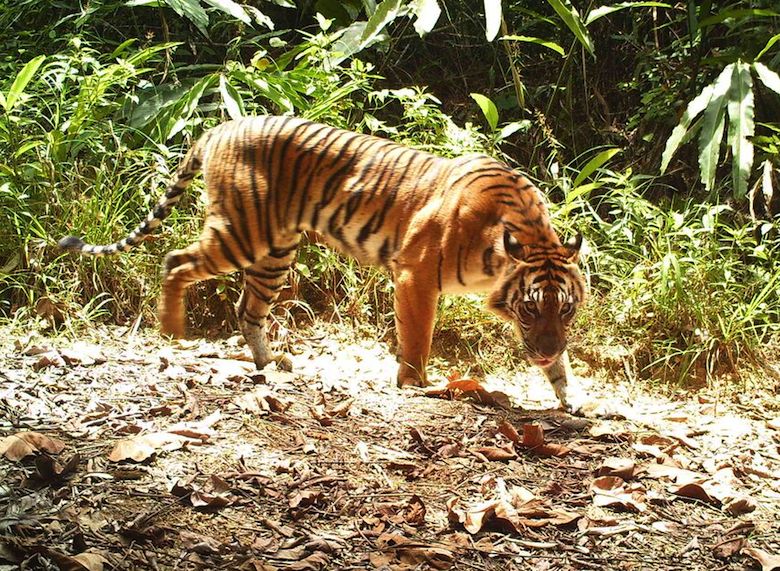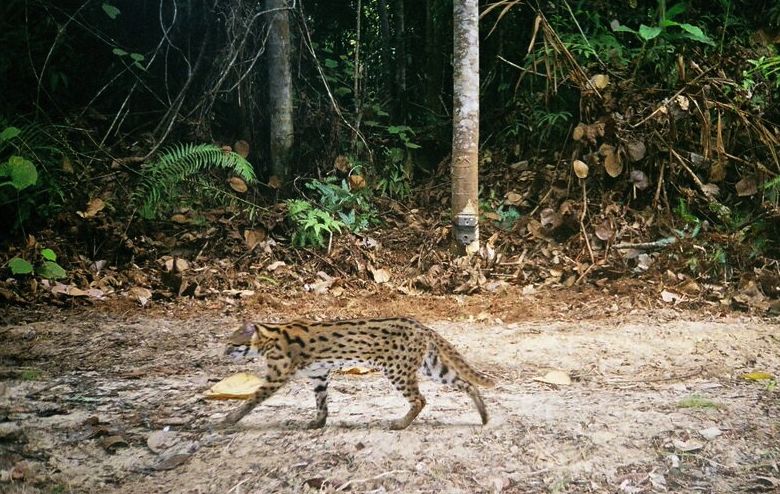At least six species of wild cats live, and seem to do so harmoniously, on the Indonesian island of Sumatra. The Sumatran tiger (Panthera tigris sumatrae) is critically endangered and several of the other cat species on the island are threatened, according to the IUCN. But with the exception of the Sumatran tiger, little is known about the various cats’ distributions and habitat preferences. A recent study published in the Journal of Zoology examines how five of Sumatra’s cat species manage to coexist and the implications for their conservation on an island with high rates of forest loss and habitat degradation.

“[Cats] play a significant role ecologically as predators,” Sunarto Surnato, an ecologist with Virginia Tech and WWF Indonesia and the study’s principal researcher, told mongabay.com. “[T]hey control and influence the population number and also the behavior of other animals, especially their potential prey assemblage and this further affects the vegetation and the overall ecosystem, including the landscape.”
Camera trapping, a useful tool for documenting shy and secretive species, has been actively used in tiger research in central Sumatra for a number of years. Sunarto and his colleagues used data collected by camera traps set primarily for tiger research. This included photographs not only of tigers and tiger cubs, but also “by-catch” photographs of prey animals and other carnivores.

The study was conducted in a 3 million hectare area of central Sumatra that includes five major protected areas. The researchers set up 104 camera stations in predetermined grids in five forested areas — three inside and two outside the protected areas — and left the cameras constantly active for three months. They also set up another 65 camera traps opportunistically, for one to three months at a stretch. They collected photographs from a total of nearly 13,000 nights.
In each of the five forest areas the researchers calculated the “trap rate” — a measure of activity level — for cats, other carnivores, potential prey, and humans. They gathered information on the habitat near each camera from mapping software and used this to model the habitat use of each cat species. Then they used these models to compare how the cat species used the various habitats over time.
The photos confirmed the presence of five species of wild cats in the study area: Sumatran tigers, Sunda clouded leopards (Neofelis diardi), Asiatic golden cats (Catopuma temminckii), marbled cats (Pardofelis marmorata), and leopard cats (Prionailurus bengalensis).


Clouded leopards and leopard cats were present and widespread in all five sampling blocks. Marbled cats were present in four, tigers in three, and golden cats only in two.
All five cat species were photographed in only one of the protected areas — Rimbang Baling Wildlife Reserve. Four species were recorded in the other two protected areas and one of the unprotected areas. And only two species — clouded leopards and leopard cats — were recorded in the other unprotected area.
The researchers hypothesized that cat species of similar body size would avoid each other, unless they had distinct morphological characteristics or physical capabilities that would allow them to hunt different prey species or use different areas of the habitat.


As predicted, species of similar body mass had the least overlap in their ranges. For example, the tiger, the largest of the cats, overlapped least with the next largest cat, the clouded leopard, and the golden cat had the next lowest overlap with the species most similar in size to it, the leopard cat.
To explain their results, the researchers describe six mechanisms that the cats might use to avoid competition and coexist peacefully: frequenting different places, frequenting different elevations, spending time in the trees versus on the ground, making use of other distinct microhabitat features, being active at different times, and targeting prey of different sizes.
The researchers compared pairs of cat species and scored which of the six mechanisms they appeared to use to share habitat. For instance, tigers, being only occasional tree climbers, may avoid competition with clouded leopards which are extremely skillful climbers and hunters within the trees. And marbled cats appeared to prefer higher elevations than leopard cats, the species nearest in size to them.


The authors write that their study has important implications for the conservation and management of the various cat species in the study area, and possibly beyond. For instance, they found that both tigers and leopard cats can live at high densities in lowland forests, potentially leaving little space for other cats. If high-elevation protected areas are not available, smaller cat species may have trouble persisting.
The authors note that the remaining forests of Sumatra, including the degraded ones, still have a high conservation value for wild cats and other wildlife.
“[E]ven the critically endangered Sumatran tiger can achieve high abundance in such forests, likely because prey is still supported in these areas,” the authors write. “[D]espite the widespread perception that rainforest animals need intact forest, we suggest that in addition to intact forested areas, protection of secondary, even degraded forests, is highly beneficial to maintaining the increasingly threatened wild cats in Sumatra.”

Citations
Sunarto, S., Kelly, M. J., Parakkasi, K. and Hutajulu, M. B. (2015), Cat coexistence in central Sumatra: ecological characteristics, spatial and temporal overlap, and implications for management. Journal of Zoology, 296: 104–115. doi: 10.1111/jzo.12218